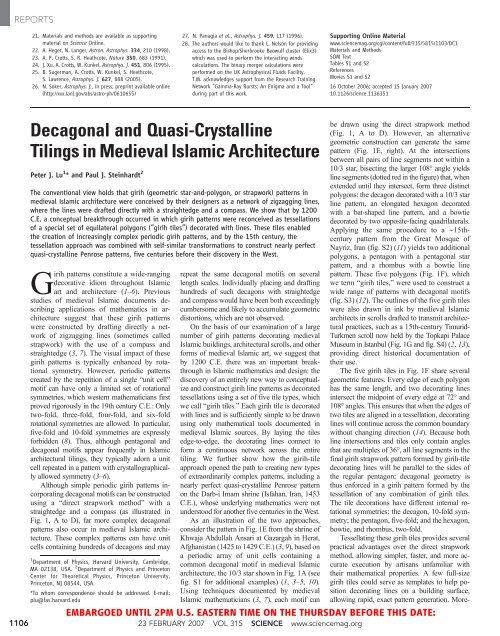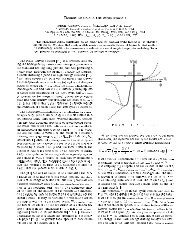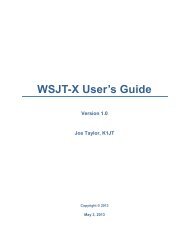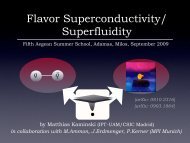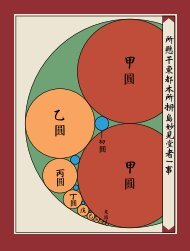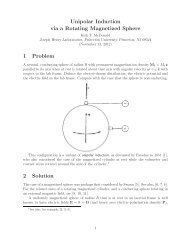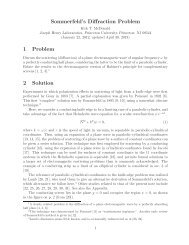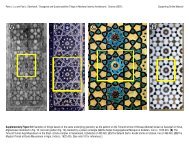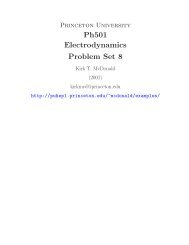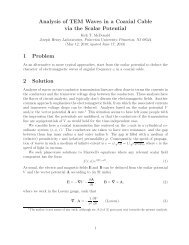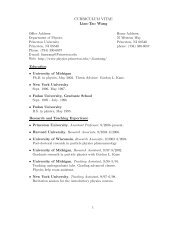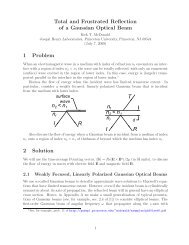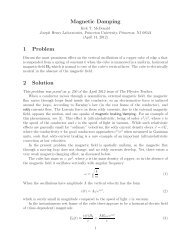Decagonal and Quasi-Crystalline Tilings in Medieval Islamic ...
Decagonal and Quasi-Crystalline Tilings in Medieval Islamic ...
Decagonal and Quasi-Crystalline Tilings in Medieval Islamic ...
Create successful ePaper yourself
Turn your PDF publications into a flip-book with our unique Google optimized e-Paper software.
REPORTS<br />
21. Materials <strong>and</strong> methods are available as support<strong>in</strong>g<br />
material on Science Onl<strong>in</strong>e.<br />
22. A. Heger, N. Langer, Astron. Astrophys. 334, 210 (1998).<br />
23. A. P. Crotts, S. R. Heathcote, Nature 350, 683 (1991).<br />
24. J. Xu, A. Crotts, W. Kunkel, Astrophys. J. 451, 806 (1995).<br />
25. B. Sugerman, A. Crotts, W. Kunkel, S. Heathcote,<br />
S. Lawrence, Astrophys. J. 627, 888 (2005).<br />
26. N. Soker, Astrophys. J., <strong>in</strong> press; prepr<strong>in</strong>t available onl<strong>in</strong>e<br />
(http://xxx.lanl.gov/abs/astro-ph/0610655)<br />
27. N. Panagia et al., Astrophys. J. 459, L17 (1996).<br />
28. The authors would like to thank L. Nelson for provid<strong>in</strong>g<br />
access to the Bishop/Sherbrooke Beowulf cluster (Elix3)<br />
which was used to perform the <strong>in</strong>teract<strong>in</strong>g w<strong>in</strong>ds<br />
calculations. The b<strong>in</strong>ary merger calculations were<br />
performed on the UK Astrophysical Fluids Facility.<br />
T.M. acknowledges support from the Research Tra<strong>in</strong><strong>in</strong>g<br />
Network “Gamma-Ray Bursts: An Enigma <strong>and</strong> a Tool”<br />
dur<strong>in</strong>g part of this work.<br />
Support<strong>in</strong>g Onl<strong>in</strong>e Material<br />
www.sciencemag.org/cgi/content/full/315/5815/1103/DC1<br />
Materials <strong>and</strong> Methods<br />
SOM Text<br />
Tables S1 <strong>and</strong> S2<br />
References<br />
Movies S1 <strong>and</strong> S2<br />
16 October 2006; accepted 15 January 2007<br />
10.1126/science.1136351<br />
1106<br />
<strong>Decagonal</strong> <strong>and</strong> <strong>Quasi</strong>-<strong>Crystall<strong>in</strong>e</strong><br />
<strong>Til<strong>in</strong>gs</strong> <strong>in</strong> <strong>Medieval</strong> <strong>Islamic</strong> Architecture<br />
Peter J. Lu 1 * <strong>and</strong> Paul J. Ste<strong>in</strong>hardt 2<br />
The conventional view holds that girih (geometric star-<strong>and</strong>-polygon, or strapwork) patterns <strong>in</strong><br />
medieval <strong>Islamic</strong> architecture were conceived by their designers as a network of zigzagg<strong>in</strong>g l<strong>in</strong>es,<br />
where the l<strong>in</strong>es were drafted directly with a straightedge <strong>and</strong> a compass. We show that by 1200<br />
C.E. a conceptual breakthrough occurred <strong>in</strong> which girih patterns were reconceived as tessellations<br />
of a special set of equilateral polygons (“girih tiles”) decorated with l<strong>in</strong>es. These tiles enabled<br />
the creation of <strong>in</strong>creas<strong>in</strong>gly complex periodic girih patterns, <strong>and</strong> by the 15th century, the<br />
tessellation approach was comb<strong>in</strong>ed with self-similar transformations to construct nearly perfect<br />
quasi-crystall<strong>in</strong>e Penrose patterns, five centuries before their discovery <strong>in</strong> the West.<br />
Girih patterns constitute a wide-rang<strong>in</strong>g<br />
decorative idiom throughout <strong>Islamic</strong><br />
art <strong>and</strong> architecture (1–6). Previous<br />
studies of medieval <strong>Islamic</strong> documents describ<strong>in</strong>g<br />
applications of mathematics <strong>in</strong> architecture<br />
suggest that these girih patterns<br />
were constructed by draft<strong>in</strong>g directly a network<br />
of zigzagg<strong>in</strong>g l<strong>in</strong>es (sometimes called<br />
strapwork) with the use of a compass <strong>and</strong><br />
straightedge (3, 7). The visual impact of these<br />
girih patterns is typically enhanced by rotational<br />
symmetry. However, periodic patterns<br />
created by the repetition of a s<strong>in</strong>gle “unit cell”<br />
motif can have only a limited set of rotational<br />
symmetries, which western mathematicians first<br />
proved rigorously <strong>in</strong> the 19th century C.E.: Only<br />
two-fold, three-fold, four-fold, <strong>and</strong> six-fold<br />
rotational symmetries are allowed. In particular,<br />
five-fold <strong>and</strong> 10-fold symmetries are expressly<br />
forbidden (8). Thus, although pentagonal <strong>and</strong><br />
decagonal motifs appear frequently <strong>in</strong> <strong>Islamic</strong><br />
architectural til<strong>in</strong>gs, they typically adorn a unit<br />
cell repeated <strong>in</strong> a pattern with crystallographically<br />
allowed symmetry (3–6).<br />
Although simple periodic girih patterns <strong>in</strong>corporat<strong>in</strong>g<br />
decagonal motifs can be constructed<br />
us<strong>in</strong>g a “direct strapwork method” with a<br />
straightedge <strong>and</strong> a compass (as illustrated <strong>in</strong><br />
Fig. 1, A to D), far more complex decagonal<br />
patterns also occur <strong>in</strong> medieval <strong>Islamic</strong> architecture.<br />
These complex patterns can have unit<br />
cells conta<strong>in</strong><strong>in</strong>g hundreds of decagons <strong>and</strong> may<br />
1 Department of Physics, Harvard University, Cambridge,<br />
MA 02138, USA. 2 Department of Physics <strong>and</strong> Pr<strong>in</strong>ceton<br />
Center for Theoretical Physics, Pr<strong>in</strong>ceton University,<br />
Pr<strong>in</strong>ceton, NJ 08544, USA.<br />
*To whom correspondence should be addressed. E-mail:<br />
plu@fas.harvard.edu<br />
repeat the same decagonal motifs on several<br />
length scales. Individually plac<strong>in</strong>g <strong>and</strong> draft<strong>in</strong>g<br />
hundreds of such decagons with straightedge<br />
<strong>and</strong> compass would have been both exceed<strong>in</strong>gly<br />
cumbersome <strong>and</strong> likely to accumulate geometric<br />
distortions, which are not observed.<br />
On the basis of our exam<strong>in</strong>ation of a large<br />
number of girih patterns decorat<strong>in</strong>g medieval<br />
<strong>Islamic</strong> build<strong>in</strong>gs, architectural scrolls, <strong>and</strong> other<br />
forms of medieval <strong>Islamic</strong> art, we suggest that<br />
by 1200 C.E. there was an important breakthrough<br />
<strong>in</strong> <strong>Islamic</strong> mathematics <strong>and</strong> design: the<br />
discovery of an entirely new way to conceptualize<br />
<strong>and</strong> construct girih l<strong>in</strong>e patterns as decorated<br />
tessellations us<strong>in</strong>g a set of five tile types, which<br />
we call “girih tiles.” Each girih tile is decorated<br />
with l<strong>in</strong>es <strong>and</strong> is sufficiently simple to be drawn<br />
us<strong>in</strong>g only mathematical tools documented <strong>in</strong><br />
medieval <strong>Islamic</strong> sources. By lay<strong>in</strong>g the tiles<br />
edge-to-edge, the decorat<strong>in</strong>g l<strong>in</strong>es connect to<br />
form a cont<strong>in</strong>uous network across the entire<br />
til<strong>in</strong>g. We further show how the girih-tile<br />
approach opened the path to creat<strong>in</strong>g new types<br />
of extraord<strong>in</strong>arily complex patterns, <strong>in</strong>clud<strong>in</strong>g a<br />
nearly perfect quasi-crystall<strong>in</strong>e Penrose pattern<br />
on the Darb-i Imam shr<strong>in</strong>e (Isfahan, Iran, 1453<br />
C.E.), whose underly<strong>in</strong>g mathematics were not<br />
understood for another five centuries <strong>in</strong> the West.<br />
As an illustration of the two approaches,<br />
consider the pattern <strong>in</strong> Fig. 1E from the shr<strong>in</strong>e of<br />
Khwaja Abdullah Ansari at Gazargah <strong>in</strong> Herat,<br />
Afghanistan (1425 to 1429 C.E.) (3, 9), based on<br />
a periodic array of unit cells conta<strong>in</strong><strong>in</strong>g a<br />
common decagonal motif <strong>in</strong> medieval <strong>Islamic</strong><br />
architecture, the 10/3 star shown <strong>in</strong> Fig. 1A (see<br />
fig. S1 for additional examples) (1, 3–5, 10).<br />
Us<strong>in</strong>g techniques documented by medieval<br />
<strong>Islamic</strong> mathematicians (3, 7), each motif can<br />
be drawn us<strong>in</strong>g the direct strapwork method<br />
(Fig. 1, A to D). However, an alternative<br />
geometric construction can generate the same<br />
pattern (Fig. 1E, right). At the <strong>in</strong>tersections<br />
between all pairs of l<strong>in</strong>e segments not with<strong>in</strong> a<br />
10/3 star, bisect<strong>in</strong>g the larger 108° angle yields<br />
l<strong>in</strong>e segments (dotted red <strong>in</strong> the figure) that, when<br />
extended until they <strong>in</strong>tersect, form three dist<strong>in</strong>ct<br />
polygons: the decagon decorated with a 10/3 star<br />
l<strong>in</strong>e pattern, an elongated hexagon decorated<br />
with a bat-shaped l<strong>in</strong>e pattern, <strong>and</strong> a bowtie<br />
decorated by two opposite-fac<strong>in</strong>g quadrilaterals.<br />
Apply<strong>in</strong>g the same procedure to a ∼15thcentury<br />
pattern from the Great Mosque of<br />
Nayriz, Iran (fig. S2) (11) yields two additional<br />
polygons, a pentagon with a pentagonal star<br />
pattern, <strong>and</strong> a rhombus with a bowtie l<strong>in</strong>e<br />
pattern. These five polygons (Fig. 1F), which<br />
we term “girih tiles,” were used to construct a<br />
wide range of patterns with decagonal motifs<br />
(fig. S3) (12). The outl<strong>in</strong>es of the five girih tiles<br />
were also drawn <strong>in</strong> <strong>in</strong>k by medieval <strong>Islamic</strong><br />
architects <strong>in</strong> scrolls drafted to transmit architectural<br />
practices, such as a 15th-century Timurid-<br />
Turkmen scroll now held by the Topkapi Palace<br />
Museum <strong>in</strong> Istanbul (Fig. 1G <strong>and</strong> fig. S4) (2, 13),<br />
provid<strong>in</strong>g direct historical documentation of<br />
their use.<br />
The five girih tiles <strong>in</strong> Fig. 1F share several<br />
geometric features. Every edge of each polygon<br />
has the same length, <strong>and</strong> two decorat<strong>in</strong>g l<strong>in</strong>es<br />
<strong>in</strong>tersect the midpo<strong>in</strong>t of every edge at 72° <strong>and</strong><br />
108° angles. This ensures that when the edges of<br />
two tiles are aligned <strong>in</strong> a tessellation, decorat<strong>in</strong>g<br />
l<strong>in</strong>es will cont<strong>in</strong>ue across the common boundary<br />
without chang<strong>in</strong>g direction (14). Because both<br />
l<strong>in</strong>e <strong>in</strong>tersections <strong>and</strong> tiles only conta<strong>in</strong> angles<br />
that are multiples of 36°, all l<strong>in</strong>e segments <strong>in</strong> the<br />
f<strong>in</strong>al girih strapwork pattern formed by girih-tile<br />
decorat<strong>in</strong>g l<strong>in</strong>es will be parallel to the sides of<br />
the regular pentagon; decagonal geometry is<br />
thus enforced <strong>in</strong> a girih pattern formed by the<br />
tessellation of any comb<strong>in</strong>ation of girih tiles.<br />
The tile decorations have different <strong>in</strong>ternal rotational<br />
symmetries: the decagon, 10-fold symmetry;<br />
the pentagon, five-fold; <strong>and</strong> the hexagon,<br />
bowtie, <strong>and</strong> rhombus, two-fold.<br />
Tessellat<strong>in</strong>g these girih tiles provides several<br />
practical advantages over the direct strapwork<br />
method, allow<strong>in</strong>g simpler, faster, <strong>and</strong> more accurate<br />
execution by artisans unfamiliar with<br />
their mathematical properties. A few full-size<br />
girih tiles could serve as templates to help position<br />
decorat<strong>in</strong>g l<strong>in</strong>es on a build<strong>in</strong>g surface,<br />
allow<strong>in</strong>g rapid, exact pattern generation. More-<br />
EMBARGOED UNTIL 2PM U.S. EASTERN TIME ON THE THURSDAY BEFORE THIS DATE:<br />
23 FEBRUARY 2007 VOL 315 SCIENCE www.sciencemag.org
over, girih tiles m<strong>in</strong>imize the accumulation of<br />
angular distortions expected <strong>in</strong> the manual draft<strong>in</strong>g<br />
of <strong>in</strong>dividual 10/3 stars, with concomitant<br />
errors <strong>in</strong> siz<strong>in</strong>g, position, <strong>and</strong> orientation.<br />
Girih tiles further enable the construction of<br />
periodic decagonal-motif patterns that do not<br />
arise naturally from the direct strapwork method.<br />
One class of such patterns repeats pentagonal<br />
motifs but entirely lacks the 10/3 stars that<br />
establish the <strong>in</strong>itial decagonal angles needed for<br />
direct draft<strong>in</strong>g with straightedge <strong>and</strong> compass.<br />
Patterns of this type appear around 1200 C.E. on<br />
Seljuk build<strong>in</strong>gs, such as the Mama Hatun<br />
Mausoleum <strong>in</strong> Tercan, Turkey (1200 C.E.;<br />
Fig. 2A) (5, 15, 16), <strong>and</strong> can be created easily<br />
by tessellat<strong>in</strong>g bowtie <strong>and</strong> hexagon girih tiles to<br />
create perfect pentagonal motifs, even <strong>in</strong> the<br />
absence of a decagon star (i.e., lack<strong>in</strong>g decagon<br />
girih tiles; see fig. S5). Even more compell<strong>in</strong>g<br />
evidence for the use of girih tiles occurs on the<br />
walls of the Gunbad-i Kabud <strong>in</strong> Maragha, Iran<br />
(1197 C.E.) (11, 17, 18), where seven of eight<br />
exterior wall panels on the octagonal tomb tower<br />
are filled with a til<strong>in</strong>g of decagons, hexagons,<br />
bowties, <strong>and</strong> rhombuses (Fig. 2, B <strong>and</strong> C).<br />
With<strong>in</strong> each wall panel, the decagonal pattern<br />
does not repeat; rather, the unit cell of this<br />
periodic til<strong>in</strong>g spans the length of two complete<br />
panels (fig. S6). The ma<strong>in</strong> decorative raised<br />
brick pattern follows the girih-tile decorat<strong>in</strong>g<br />
l<strong>in</strong>es of Fig. 1F. However, a second set of<br />
smaller decorative l<strong>in</strong>es conforms to the <strong>in</strong>ternal<br />
rotational symmetry of each <strong>in</strong>dividual girih tile<br />
without adher<strong>in</strong>g to pentagonal angles (Fig. 2, C<br />
<strong>and</strong> D): With<strong>in</strong> each region occupied by a<br />
hexagon, bowtie, or rhombus, the smaller l<strong>in</strong>e<br />
decoration has a two-fold, not five-fold, rotational<br />
symmetry, <strong>and</strong> therefore could not have been<br />
generated us<strong>in</strong>g the direct strapwork method. By<br />
contrast, construct<strong>in</strong>g both patterns is straightforward<br />
with girih tiles. Two sets of l<strong>in</strong>e decoration<br />
were applied to each girih tile: the<br />
A B C D<br />
E<br />
G<br />
Fig. 1. Direct strapwork <strong>and</strong> girih-tile construction of 10/3 decagonal patterns. (A to D) Generation<br />
of a common 10/3 star pattern by the direct strapwork method. (A) A circle is divided equally <strong>in</strong>to 10,<br />
<strong>and</strong> every third vertex is connected by a straight l<strong>in</strong>e to create the 10/3 star that (B) is centered <strong>in</strong> a<br />
rectangle whose width is the circle’s diameter. In each step, new l<strong>in</strong>es drafted are <strong>in</strong>dicated <strong>in</strong> blue,<br />
l<strong>in</strong>es to be deleted are <strong>in</strong> red, <strong>and</strong> purple construction l<strong>in</strong>es not <strong>in</strong> the f<strong>in</strong>al pattern are <strong>in</strong> dashed<br />
purple. (E) Periodic pattern at the Timurid shr<strong>in</strong>e of Khwaja Abdullah Ansari at Gazargah <strong>in</strong> Herat,<br />
Afghanistan (1425 to 1429 C.E.), where the unit cell pattern (D) is <strong>in</strong>dicated by the yellow rectangle.<br />
The same pattern can be obta<strong>in</strong>ed by tessellat<strong>in</strong>g girih tiles (overlaid at right). (F) The complete set<br />
of girih tiles: decagon, pentagon, hexagon, bowtie, <strong>and</strong> rhombus. (G) Ink outl<strong>in</strong>es for these five girih<br />
tiles appear <strong>in</strong> panel 28 of the Topkapi scroll, where we have colored one of each girih tile accord<strong>in</strong>g<br />
to the color scheme <strong>in</strong> (F).<br />
F<br />
st<strong>and</strong>ard l<strong>in</strong>e decoration of Fig. 1F, <strong>and</strong> a second,<br />
nonpentagonal set of motifs with an overall twofold<br />
symmetry (Fig. 2, C <strong>and</strong> D). The girih tiles<br />
were then tessellated, with the regular l<strong>in</strong>e pattern<br />
expressed <strong>in</strong> large raised brick on the tower <strong>and</strong><br />
the second set of l<strong>in</strong>es expressed <strong>in</strong> smaller<br />
bricks. The dual-layer nature of l<strong>in</strong>e patterns on<br />
the Maragha tower thus adds strong evidence that<br />
the pattern was generated by tessellat<strong>in</strong>g with the<br />
girih tiles <strong>in</strong> Fig. 1F.<br />
Perhaps the most strik<strong>in</strong>g <strong>in</strong>novation aris<strong>in</strong>g<br />
from the application of girih tiles was the use of<br />
self-similarity transformation (the subdivision of<br />
large girih tiles <strong>in</strong>to smaller ones) to create overlapp<strong>in</strong>g<br />
patterns at two different length scales, <strong>in</strong><br />
which each pattern is generated by the same<br />
girih tile shapes. Examples of subdivision can be<br />
found <strong>in</strong> the Topkapi scroll (e.g., Fig. 1G; see<br />
also fig. S4A) <strong>and</strong> on the Friday Mosque (17)<br />
<strong>and</strong> Darb-i Imam shr<strong>in</strong>e (1453 C.E.) (2, 9, 19)<strong>in</strong><br />
Isfahan, Iran. A sp<strong>and</strong>rel from the Darb-i Imam<br />
shr<strong>in</strong>e is shown <strong>in</strong> Fig. 3A. The large, thick,<br />
black l<strong>in</strong>e pattern consist<strong>in</strong>g of a h<strong>and</strong>ful of<br />
decagons <strong>and</strong> bowties (Fig. 3C) is subdivided<br />
<strong>in</strong>to the smaller pattern, which can also be<br />
perfectly generated by a tessellation of 231<br />
girih tiles (Fig. 3B; l<strong>in</strong>e decoration of Fig. 1F<br />
filled <strong>in</strong> with solid color here). We have<br />
identified the subdivision rule used to generate<br />
the Darb-i Imam sp<strong>and</strong>rel pattern (Fig. 3, D<br />
<strong>and</strong> E), which was also used on other patterns<br />
on the Darb-i Imam shr<strong>in</strong>e <strong>and</strong> Isfahan Friday<br />
Mosque (fig. S7).<br />
A subdivision rule, comb<strong>in</strong>ed with decagonal<br />
symmetry, is sufficient to construct perfect<br />
quasi-crystall<strong>in</strong>e til<strong>in</strong>gs—patterns with <strong>in</strong>f<strong>in</strong>ite<br />
perfect quasi-periodic translational order <strong>and</strong><br />
crystallographically forbidden rotational symmetries,<br />
such as pentagonal or decagonal—<br />
which mathematicians <strong>and</strong> physicists have come<br />
to underst<strong>and</strong> only <strong>in</strong> the past 30 years (20, 21).<br />
<strong>Quasi</strong>-periodic order means that dist<strong>in</strong>ct tile<br />
shapes repeat with frequencies that are <strong>in</strong>commensurate;<br />
that is, the ratio of the frequencies<br />
cannot be expressed as a ratio of <strong>in</strong>tegers. By<br />
hav<strong>in</strong>g quasi-periodicity rather than periodicity,<br />
the symmetry constra<strong>in</strong>ts of conventional crystallography<br />
can be violated, <strong>and</strong> it is possible to<br />
have pentagonal motifs that jo<strong>in</strong> together <strong>in</strong> a<br />
pattern with overall pentagonal <strong>and</strong> decagonal<br />
symmetry (21).<br />
The most famous example of a quasicrystall<strong>in</strong>e<br />
til<strong>in</strong>g is the Penrose til<strong>in</strong>g (20, 22), a<br />
two-tile tessellation with long-range quasiperiodic<br />
translational order <strong>and</strong> five-fold<br />
symmetry. The Penrose tiles can have various<br />
shapes. A convenient choice for comparison<br />
with medieval <strong>Islamic</strong> architectural decoration is<br />
the kite <strong>and</strong> dart shown on the left side of Fig. 4,<br />
A <strong>and</strong> B. As orig<strong>in</strong>ally conceived by Penrose <strong>in</strong><br />
the 1970s, the til<strong>in</strong>gs can be constructed either<br />
by “match<strong>in</strong>g rules” or by self-similar subdivisions.<br />
For the match<strong>in</strong>g rules, the kite <strong>and</strong> dart<br />
can each be decorated with red <strong>and</strong> blue stripes<br />
(Fig. 4, A <strong>and</strong> B); when tiles are placed so that<br />
EMBARGOED UNTIL 2PM U.S. EASTERN TIME ON THE THURSDAY BEFORE THIS DATE:<br />
REPORTS<br />
www.sciencemag.org SCIENCE VOL 315 23 FEBRUARY 2007 1107
REPORTS<br />
1108<br />
the stripes cont<strong>in</strong>ue un<strong>in</strong>terrupted, the only possible<br />
close-packed arrangement is a five-fold<br />
symmetric quasi-crystall<strong>in</strong>e pattern <strong>in</strong> which the<br />
kites <strong>and</strong> darts repeat with frequencies whose<br />
ratio is p ffiffi irrational, namely, the golden ratio t ≡<br />
(1 + 5 )/2 ≈ 1.618. We see no evidence that<br />
<strong>Islamic</strong> designers used the match<strong>in</strong>g-rule approach.<br />
The second approach is to repeatedly<br />
subdivide kites <strong>and</strong> darts <strong>in</strong>to smaller kites <strong>and</strong><br />
darts, accord<strong>in</strong>g to the rules shown <strong>in</strong> Fig. 4, A<br />
<strong>and</strong> B. This self-similar subdivision of large tiles<br />
<strong>in</strong>to small tiles can be expressed <strong>in</strong> terms of a<br />
transformation matrix whose eigenvalues are irrational,<br />
a signature of quasi-periodicity; the<br />
eigenvalues represent the ratio of tile frequencies<br />
<strong>in</strong> the limit of an <strong>in</strong>f<strong>in</strong>ite til<strong>in</strong>g (23).<br />
Our analysis <strong>in</strong>dicates that <strong>Islamic</strong> designers<br />
had all the conceptual elements necessary to<br />
produce quasi-crystall<strong>in</strong>e girih patterns us<strong>in</strong>g the<br />
self-similar transformation method: girih tiles,<br />
decagonal symmetry, <strong>and</strong> subdivision. The<br />
pattern on the Darb-i Imam shr<strong>in</strong>e is a remarkable<br />
example of how these pr<strong>in</strong>ciples were<br />
applied. Us<strong>in</strong>g the self-similar subdivision of<br />
large girih tiles <strong>in</strong>to small ones shown <strong>in</strong> Fig. 3,<br />
D <strong>and</strong> E, an arbitrarily large Darb-i Imam pattern<br />
can be constructed. The asymptotic ratio of<br />
hexagons to bowties approaches the golden ratio<br />
t (the same ratio as kites to darts <strong>in</strong> a Penrose<br />
til<strong>in</strong>g), an irrational ratio that shows explicitly<br />
that the pattern is quasi-periodic.<br />
Moreover, the Darb-i Imam tile pattern can<br />
be mapped directly <strong>in</strong>to Penrose tiles follow<strong>in</strong>g<br />
the prescription for the hexagon, bowtie (22),<br />
<strong>and</strong> decagon given <strong>in</strong> Fig. 4, C to E. Us<strong>in</strong>g these<br />
substitutions, both the large (Fig. 3C) <strong>and</strong> small<br />
(Fig. 3B) girih-tile patterns on the Darb-i Imam<br />
can be mapped completely <strong>in</strong>to Penrose tiles<br />
(fig. S8). Note that the mapp<strong>in</strong>g shown <strong>in</strong> Fig. 4,<br />
C to E, breaks the bilateral symmetries of the<br />
girih tiles; as a result, for an <strong>in</strong>dividual tile,<br />
there is a discrete number of choices for the<br />
mapp<strong>in</strong>g: 10 for the decagon, two each for<br />
hexagon <strong>and</strong> bowtie. Therefore, the mapp<strong>in</strong>g is<br />
completed by us<strong>in</strong>g this freedom to elim<strong>in</strong>ate<br />
Penrose tile edge mismatches to the maximum<br />
degree possible. Note that, unlike previous<br />
comparisons <strong>in</strong> the literature between <strong>Islamic</strong><br />
designs with decagonal motifs <strong>and</strong> Penrose tiles<br />
(18, 24), the Darb-i Imam tessellation is not<br />
embedded <strong>in</strong> a periodic framework <strong>and</strong> can, <strong>in</strong><br />
pr<strong>in</strong>ciple, be extended <strong>in</strong>to an <strong>in</strong>f<strong>in</strong>ite quasiperiodic<br />
pattern.<br />
Although the Darb-i Imam pattern illustrates<br />
that <strong>Islamic</strong> designers had all the elements<br />
needed to construct perfect quasi-crystall<strong>in</strong>e patterns,<br />
we nonetheless f<strong>in</strong>d <strong>in</strong>dications that the<br />
designers had an <strong>in</strong>complete underst<strong>and</strong><strong>in</strong>g of<br />
these elements. First, we have no evidence that<br />
they ever developed the alternative match<strong>in</strong>g-rule<br />
approach. Second, there are a small number of<br />
tile mismatches, local imperfections <strong>in</strong> the Darb-i<br />
Imam til<strong>in</strong>g. These can be visualized by mapp<strong>in</strong>g<br />
the til<strong>in</strong>g <strong>in</strong>to the Penrose tiles <strong>and</strong> identify<strong>in</strong>g<br />
the mismatches. However, there are only a few<br />
of them—11 mismatches out of 3700 Penrose<br />
tiles—<strong>and</strong> every mismatch is po<strong>in</strong>t-like, removable<br />
with a local rearrangement of a few tiles<br />
without affect<strong>in</strong>g the rest of the pattern (Fig. 4F<br />
<strong>and</strong> fig. S8). This is the k<strong>in</strong>d of defect that an<br />
artisan could have made <strong>in</strong>advertently <strong>in</strong> construct<strong>in</strong>g<br />
or repair<strong>in</strong>g a complex pattern. Third,<br />
the designers did not beg<strong>in</strong> with a s<strong>in</strong>gle girih<br />
tile, but rather with a small arrangement of large<br />
tiles that does not appear <strong>in</strong> the subdivided pattern.<br />
This arbitrary <strong>and</strong> unnecessary choice<br />
means that, strictly speak<strong>in</strong>g, the til<strong>in</strong>g is not<br />
A<br />
B<br />
D<br />
self-similar, although repeated application of<br />
the subdivision rule would nonetheless lead<br />
to the same irrational t ratio of hexagons to<br />
bowties.<br />
Our work suggests several avenues for further<br />
<strong>in</strong>vestigation. Although the examples we<br />
have studied thus far fall just short of be<strong>in</strong>g<br />
perfect quasi-crystals, there may be more <strong>in</strong>terest<strong>in</strong>g<br />
examples yet to be discovered, <strong>in</strong>clud<strong>in</strong>g<br />
perfectly quasi-periodic decagonal patterns. The<br />
subdivision analysis outl<strong>in</strong>ed above establishes a<br />
procedure for identify<strong>in</strong>g quasi-periodic patterns<br />
Fig. 2. (A) Periodic girih pattern from the Seljuk Mama Hatun Mausoleum <strong>in</strong> Tercan, Turkey<br />
(~1200 C.E.), where all l<strong>in</strong>es are parallel to the sides of a regular pentagon, even though no<br />
decagon star is present; reconstruction overlaid at right with the hexagon <strong>and</strong> bowtie girih tiles of<br />
Fig. 1F. (B) Photograph by A. Sevrugu<strong>in</strong> (~1870s) of the octagonal Gunbad-i Kabud tomb tower <strong>in</strong><br />
Maragha, Iran (1197 C.E.), with the girih-tile reconstruction of one panel overlaid. (C) Close-up of<br />
the area marked by the dotted yellow rectangle <strong>in</strong> (B). (D) Hexagon, bowtie, <strong>and</strong> rhombus girih<br />
tiles with additional small-brick pattern reconstruction (<strong>in</strong>dicated <strong>in</strong> white) that conforms not to the<br />
pentagonal geometry of the overall pattern, but to the <strong>in</strong>ternal two-fold rotational symmetry of the<br />
<strong>in</strong>dividual girih tiles.<br />
EMBARGOED UNTIL 2PM U.S. EASTERN TIME ON THE THURSDAY BEFORE THIS DATE:<br />
23 FEBRUARY 2007 VOL 315 SCIENCE www.sciencemag.org<br />
C
<strong>and</strong> measur<strong>in</strong>g their degree of perfection. Also,<br />
analogous girih tiles may exist for other noncrystallographic<br />
symmetries, <strong>and</strong> similar dotted<br />
A<br />
tile outl<strong>in</strong>es for nondecagonal patterns appear <strong>in</strong><br />
the Topkapi scroll. F<strong>in</strong>ally, although our analysis<br />
shows that complex decagonal til<strong>in</strong>gs were be<strong>in</strong>g<br />
REPORTS<br />
made by 1200 C.E., exactly when the shift from<br />
the direct strapwork to the girih-tile paradigm<br />
first occurred is an open question, as is the<br />
identity of the designers of these complex<br />
<strong>Islamic</strong> patterns, whose geometrical sophistication<br />
led the medieval world.<br />
B<br />
C<br />
D<br />
Fig. 3. Girih-tile subdivision found <strong>in</strong> the decagonal girih pattern on a sp<strong>and</strong>rel from the Darb-i<br />
Imam shr<strong>in</strong>e, Isfahan, Iran (1453 C.E.). (A) Photograph of the right half of the sp<strong>and</strong>rel. (B)<br />
Reconstruction of the smaller-scale pattern us<strong>in</strong>g girih tiles where the blue-l<strong>in</strong>e decoration <strong>in</strong> Fig.<br />
1F has been filled <strong>in</strong> with solid color. (C) Reconstruction of the larger-scale thick l<strong>in</strong>e pattern with<br />
larger girih tiles, overlaid on the build<strong>in</strong>g photograph. (D <strong>and</strong> E) Graphical depiction of the<br />
subdivision rules transform<strong>in</strong>g the large bowtie (D) <strong>and</strong> decagon (E) girih-tile pattern <strong>in</strong>to the small<br />
girih-tile pattern on til<strong>in</strong>gs from the Darb-i Imam shr<strong>in</strong>e <strong>and</strong> Friday Mosque of Isfahan.<br />
E<br />
References <strong>and</strong> Notes<br />
1. J. Bourgo<strong>in</strong>, <strong>in</strong> Les elements de l’art arabe; le trait des<br />
entrelacs (Firm<strong>in</strong>-Didot, Paris, 1879), p. 176.<br />
2. G. Necipoglu, The Topkapi Scroll: Geometry <strong>and</strong><br />
Ornament <strong>in</strong> <strong>Islamic</strong> Architecture (Getty Center for the<br />
History of Art <strong>and</strong> the Humanities, Santa Monica, CA,<br />
1995).<br />
3. I. El-Said, A. Parman, <strong>in</strong> Geometric Concepts <strong>in</strong> <strong>Islamic</strong><br />
Art (World of Islam Festival, London, 1976), pp. 85–87.<br />
4. S. J. Abas, A. S. Salman, <strong>in</strong> Symmetries of <strong>Islamic</strong><br />
Geometrical Patterns (World Scientific, S<strong>in</strong>gapore,<br />
1995), p. 95.<br />
5. Y. Demiriz, <strong>in</strong> Islam Sanat<strong>in</strong>da Geometrik Susleme (Lebib<br />
Yalk<strong>in</strong>, Istanbul, 2000), pp. 27, 128–129.<br />
6. G. Schneider, <strong>in</strong> Geometrische Bauornamente der<br />
Seldschuken <strong>in</strong> Kle<strong>in</strong>asien (Reichert, Wiesbaden,<br />
Germany, 1980), pp. 136–139, plate 3.<br />
7. Abu’l-Wafa al-Buzjani’s (940–998 C.E.) treatise On the<br />
Geometric Constructions Necessary for the Artisan, <strong>and</strong><br />
an anonymous manuscript appended to a Persian<br />
translation of al-Buzjani <strong>and</strong> likely dat<strong>in</strong>g from the 13th<br />
century, On Interlocks of Similar or Correspond<strong>in</strong>g<br />
Figures (2), document specific techniques for<br />
architecturally related mathematical constructions (2, 25).<br />
The mathematical tools needed to construct the girih<br />
tiles are entirely conta<strong>in</strong>ed <strong>in</strong> these two manuscripts—<br />
specifically, bisection, division of a circle <strong>in</strong>to five equal<br />
parts, <strong>and</strong> cutt<strong>in</strong>g <strong>and</strong> rearrangement of paper tiles to<br />
create geometric patterns.<br />
8. A. Bravais, J. Ec. Polytech. 33, 1 (1850).<br />
9. L. Golombek, D. Wilber, <strong>in</strong> The Timurid Architecture of<br />
Iran <strong>and</strong> Turan (Pr<strong>in</strong>ceton Univ. Press, Pr<strong>in</strong>ceton, NJ,<br />
1988), pp. 246–250, 308–309, 384–386, 389, color<br />
plates IV, IXb, plates 46, 374.<br />
10. Additional examples of this particular 10/3 decagonal<br />
pattern, shown <strong>in</strong> fig. S1: the Seljuk Congregational<br />
Mosque <strong>in</strong> Ardistan, Iran (~1160 C.E.) (16); the Timurid<br />
Tuman Aqa Mausoleum <strong>in</strong> the Shah-i Z<strong>in</strong>da complex <strong>in</strong><br />
Samark<strong>and</strong>, Uzbekistan (1405 C.E.) (9, 16); the Darb-i<br />
Kushk shr<strong>in</strong>e <strong>in</strong> Isfahan, Iran (1496 C.E.) (2, 9, 17); <strong>and</strong><br />
the Mughal I’timad al-Daula Mausoleum <strong>in</strong> Agra, India<br />
(~1622 C.E.) (28).<br />
11. R. Ett<strong>in</strong>ghausen, O. Grabar, M. Jenk<strong>in</strong>s-Mad<strong>in</strong>a, <strong>in</strong> <strong>Islamic</strong><br />
Art <strong>and</strong> Architecture 650–1250 (Yale Univ. Press, New<br />
Haven, CT, 2001), p. 109.<br />
12. Additional architectural examples of patterns that can be<br />
reconstructed with girih tiles, shown <strong>in</strong> fig. S3: the<br />
Abbasid Al-Mustansiriyya Madrasa <strong>in</strong> Baghdad, Iraq<br />
(1227 to 1234 C.E.) (26); the Ilkhanid Uljaytu<br />
Mausoleum <strong>in</strong> Sultaniya, Iran (1304 C.E.) (17); the<br />
Ottoman Green Mosque <strong>in</strong> Bursa, Turkey (1424 C.E.)<br />
(27); <strong>and</strong> the Mughal I’timad al-Daula Mausoleum <strong>in</strong><br />
Agra, India (~1622 C.E.) (28). Similar patterns also<br />
appear <strong>in</strong> the Mamluk Qurans of S<strong>and</strong>al (1306 to<br />
1315 C.E.) <strong>and</strong> of Aydughdi ibn Abdallah al-Badri<br />
(1313 C.E.) (29). Note that the girih-tile paradigm can<br />
make pattern design structure more clear. For example,<br />
all of the sp<strong>and</strong>rels with decagonal girih patterns we<br />
have thus far exam<strong>in</strong>ed (<strong>in</strong>clud<strong>in</strong>g Fig. 3C <strong>and</strong> figs. S2<br />
<strong>and</strong> S3A) follow the same prescription to place decagons:<br />
Partial decagons are centered at the four external<br />
corners <strong>and</strong> on the top edge directly above the apex<br />
of the arch.<br />
13. A similar convention was used to mark the same girih<br />
tiles <strong>in</strong> other panels (e.g., 28, 50, 52, <strong>and</strong> 62) <strong>in</strong> the<br />
Topkapi scroll (fig. S4) (2).<br />
14. E. H. Hank<strong>in</strong>, The Draw<strong>in</strong>g of Geometric Patterns <strong>in</strong><br />
Saracenic Art (Government of India Central Publications<br />
Branch, Calcutta, 1925), p. 4.<br />
15. This pattern type also occurs on the Great Mosque <strong>in</strong><br />
Malatya, Turkey (~1200 C.E.) (6), <strong>and</strong> the madrasa <strong>in</strong><br />
EMBARGOED UNTIL 2PM U.S. EASTERN TIME ON THE THURSDAY BEFORE THIS DATE:<br />
www.sciencemag.org SCIENCE VOL 315 23 FEBRUARY 2007 1109
REPORTS<br />
Fig. 4. (A <strong>and</strong> B) The A<br />
kite (A) <strong>and</strong> dart (B)<br />
Penrose tile shapes are<br />
shown at the left of the<br />
arrows with red <strong>and</strong> blue<br />
ribbons that match cont<strong>in</strong>uously<br />
across the edges<br />
C<br />
<strong>in</strong> a perfect Penrose til<strong>in</strong>g.<br />
Given a f<strong>in</strong>ite til<strong>in</strong>g fragment,<br />
each tile can be<br />
subdivided accord<strong>in</strong>g to D<br />
the “<strong>in</strong>flation rules” <strong>in</strong>to<br />
smaller kites <strong>and</strong> darts (at<br />
the right of the arrows)<br />
that jo<strong>in</strong> together to form E<br />
a perfect fragment with<br />
more tiles. (C to E) Mapp<strong>in</strong>gs<br />
between girih tiles<br />
<strong>and</strong> Penrose tiles for<br />
elongated hexagon (C),<br />
bowtie (D), <strong>and</strong> decagon<br />
(E). (F) Mapp<strong>in</strong>g of a region<br />
of small girih tiles to<br />
Penrose tiles, correspond<strong>in</strong>g<br />
to the area marked by<br />
thewhiterectangle<strong>in</strong>Fig.<br />
3B, from the Darb-i Imam F<br />
shr<strong>in</strong>e. At the left is a region<br />
mapped to Penrose<br />
tiles follow<strong>in</strong>g the rules<br />
<strong>in</strong> (C) to (E). The pair of<br />
colored tiles outl<strong>in</strong>ed <strong>in</strong><br />
purple have a po<strong>in</strong>t defect<br />
(the Penrose edge<br />
mismatches are <strong>in</strong>dicated<br />
with yellow dotted l<strong>in</strong>es)<br />
that can be removed by<br />
flipp<strong>in</strong>g positions of the<br />
bowtie <strong>and</strong> hexagon, as<br />
shownontheright,yield<strong>in</strong>gaperfect, defect-free Penrose til<strong>in</strong>g.<br />
Zuzan, Iran (1219 C.E.) (30) (fig. S5), as well as on a<br />
carved wooden double door from a Seljuk build<strong>in</strong>g <strong>in</strong><br />
Konya (~13th century C.E.), <strong>in</strong> the Museum of <strong>Islamic</strong> Art<br />
<strong>in</strong> Berl<strong>in</strong> (Inv. Nr. 1.2672).<br />
16. D. Hill, O. Grabar, <strong>in</strong> <strong>Islamic</strong> Architecture <strong>and</strong> its<br />
B<br />
Decoration, A.D. 800–1500 (Univ. of Chicago Press,<br />
Chicago, 1964), pp. 53, 62, 65, plates 38, 276, 346, 348.<br />
17. S. P. Seherr-Thoss, Design <strong>and</strong> Color <strong>in</strong> <strong>Islamic</strong><br />
Architecture (Smithsonian Institution, Wash<strong>in</strong>gton, DC,<br />
1968), plates 34–36, 40, 84, 90.<br />
18. E. Makovicky, <strong>in</strong> Fivefold Symmetry, I. Hargittai, Ed.<br />
(World Scientific, S<strong>in</strong>gapore, 1992), pp. 67–86.<br />
19. J. F. Bonner, <strong>in</strong> ISAMA/Bridges Conference Proceed<strong>in</strong>gs,<br />
R. Sarhangi, N. Friedman, Eds. (Univ. of Granada,<br />
Granada, Spa<strong>in</strong>, 2003), pp. 1–12.<br />
20. R. Penrose, Bull. Inst. Math. Appl. 10, 266 (1974).<br />
21. D. Lev<strong>in</strong>e, P. J. Ste<strong>in</strong>hardt, Phys. Rev. Lett. 53, 2477<br />
(1984).<br />
22. M. Gardner, <strong>in</strong> Penrose Tiles to Trapdoor Ciphers<br />
(Freeman, New York, 1989), pp. 1–29.<br />
23. D. Lev<strong>in</strong>e, P. J. Ste<strong>in</strong>hardt, Phys. Rev. B 34, 596 (1986).<br />
24. A s<strong>in</strong>gle figure, part of a geometric proof from On<br />
Interlocks of Similar or Correspond<strong>in</strong>g Figures, has been<br />
related to the outl<strong>in</strong>es of <strong>in</strong>dividual Penrose tiles, but<br />
there is no evidence whatsoever for tessellation (31).<br />
Makovicky has connected the Maragha Gunbad-i Kabud<br />
pattern <strong>in</strong> Fig. 2 with the Penrose til<strong>in</strong>g (18), but<br />
explicitly states (as we show <strong>in</strong> fig. S6) that the pattern is<br />
periodic, so by def<strong>in</strong>ition it cannot be a properly quasiperiodic<br />
Penrose til<strong>in</strong>g.<br />
25. A. Ozdural, Hist. Math. 27, 171 (2000).<br />
26. H. Schmid, Die Madrasa des Kalifen Al-Mustansir <strong>in</strong><br />
Baghdad (Zabern, Ma<strong>in</strong>z, Germany, 1980), plates 15, 87.<br />
27. G. Goodw<strong>in</strong>, A History of Ottoman Architecture (Thames<br />
<strong>and</strong> Hudson, London, 1971), pp. 58–65.<br />
28. Y. Ishimoto, Islam: Space <strong>and</strong> Design (Sh<strong>in</strong>sh<strong>in</strong>do, Kyoto,<br />
1980), plates 378, 380, 382.<br />
29. D. James, Qur’ans of the Mamluks (Thames <strong>and</strong> Hudson,<br />
New York, 1988), pp. 54, 57–59.<br />
30. R. Hillenbr<strong>and</strong>, <strong>Islamic</strong> Architecture (Columbia Univ.<br />
Press, New York, 1994), pp. 182–183.<br />
31. W. K. Chorbachi, Comp. Math. Appl. 17, 751<br />
(1989).<br />
32. We thank G. Necipoglu <strong>and</strong> J. Spurr, without whose<br />
multifaceted assistance this paper would not have been<br />
possible. We also thank R. Holod <strong>and</strong> K. Dudley/M. Eniff<br />
for permission to reproduce their photographs <strong>in</strong> Figs. 2C<br />
<strong>and</strong> 3A, respectively; C. Tam <strong>and</strong> E. Simon-Brown for<br />
logistical assistance <strong>in</strong> Uzbekistan; S. Siavoshi <strong>and</strong><br />
A. Tafvizi for motivat<strong>in</strong>g the exploration of Isfahan’s<br />
sights; <strong>and</strong> S. Blair, J. Bloom, C. Eisenmann, T. Lentz, <strong>and</strong><br />
I. W<strong>in</strong>ter for manuscript comments. Photographs <strong>in</strong><br />
Fig. 2, A <strong>and</strong> B, <strong>and</strong> <strong>in</strong> the onl<strong>in</strong>e figures courtesy of the<br />
F<strong>in</strong>e Arts Library, Harvard College Library. Supported by<br />
C. <strong>and</strong> F. Lu <strong>and</strong> by the Aga Khan Program for <strong>Islamic</strong><br />
Architecture at Harvard University.<br />
Support<strong>in</strong>g Onl<strong>in</strong>e Material<br />
www.sciencemag.org/cgi/content/full/315/5815/[page]/DC1<br />
Figs. S1 to S8<br />
25 September 2006; accepted 22 December 2006<br />
10.1126/science.1135491<br />
Ex Situ NMR <strong>in</strong> Highly Homogeneous<br />
Fields: 1 H Spectroscopy<br />
Juan Perlo, Federico Casanova, Bernhard Blümich*<br />
Portable s<strong>in</strong>gle-sided nuclear magnetic resonance (NMR) magnets used for nondestructive studies<br />
of large samples are believed to generate <strong>in</strong>herently <strong>in</strong>homogeneous magnetic fields. We<br />
demonstrated experimentally that the field of an open magnet can be shimmed to high homogeneity<br />
<strong>in</strong> a large volume external to the sensor. This technique allowed us to measure localized highresolution<br />
proton spectra outside a portable open magnet with a spectral resolution of 0.25 part<br />
per million. The generation of these experimental conditions also simplifies the implementation of<br />
such powerful methodologies as multidimensional NMR spectroscopy <strong>and</strong> imag<strong>in</strong>g.<br />
adapted to fit <strong>in</strong>to the bore of large superconduct<strong>in</strong>g<br />
magnets, s<strong>in</strong>gle-sided NMR experiments<br />
use portable open magnets placed on one side of<br />
an object to detect NMR signals ex situ. This<br />
configuration is convenient for the nondestructive<br />
<strong>in</strong>spection of valuable objects from which<br />
fragmentary samples cannot be drawn, but it does<br />
not allow generation of the high <strong>and</strong> homogeneous<br />
magnetic fields that afford spectral<br />
resolution <strong>in</strong> conventional NMR studies. Given<br />
these detrimental conditions, the st<strong>and</strong>ard techniques<br />
of conventional NMR do not work, <strong>and</strong><br />
new strategies need to be developed <strong>in</strong> order to<br />
extract valuable <strong>in</strong>formation from the NMR<br />
signal (2–8).<br />
Start<strong>in</strong>g from simple relaxation-time measurements,<br />
more sophisticated methods of ex situ<br />
NMR have been developed, such as Fourier<br />
imag<strong>in</strong>g (5), velocity imag<strong>in</strong>g (6), <strong>and</strong> multi-<br />
1110<br />
S<strong>in</strong>gle-sided nuclear magnetic resonance<br />
(NMR) sensors have been used for over<br />
two decades to characterize arbitrarily<br />
large samples (1). In contrast to conventional<br />
NMR apparatus, where the sample must be<br />
Institut für Technische Chemie und Makromolekulare<br />
Chemie, Rhe<strong>in</strong>isch-Westfälische Technische Hochschule–<br />
Aachen, D-52056, Germany.<br />
*To whom correspondence should be addressed. E-mail:<br />
bluemich@mc.rwth-aachen.de<br />
EMBARGOED UNTIL 2PM U.S. EASTERN TIME ON THE THURSDAY BEFORE THIS DATE:<br />
23 FEBRUARY 2007 VOL 315 SCIENCE www.sciencemag.org


